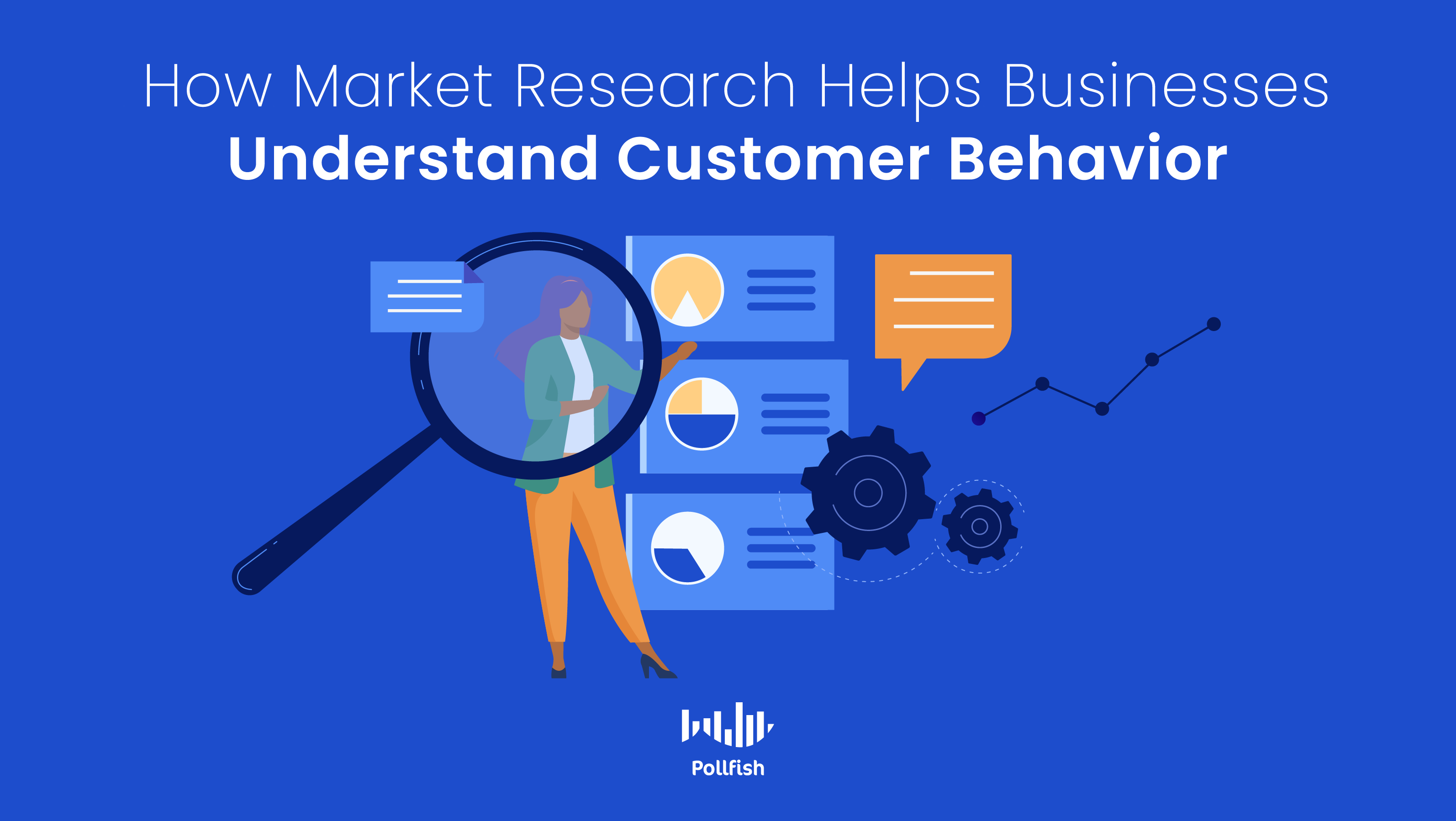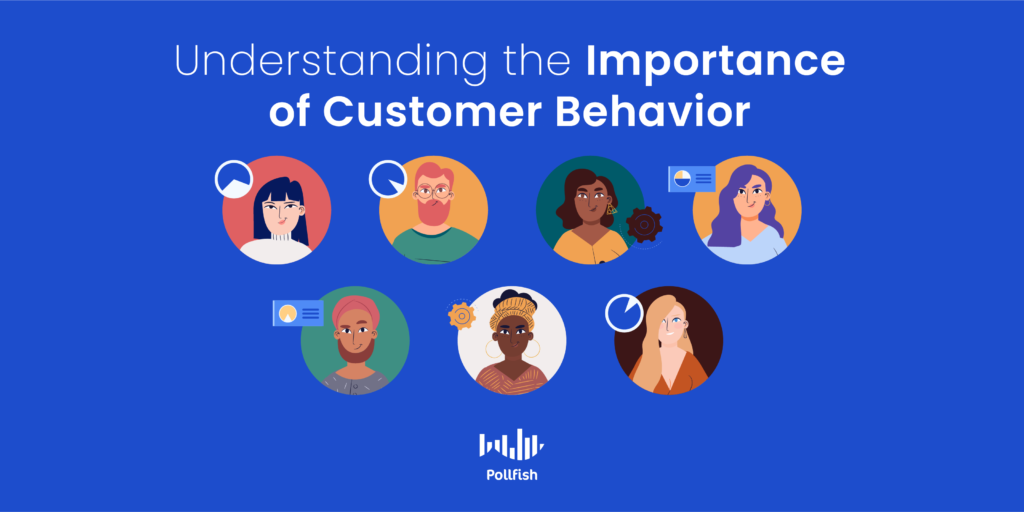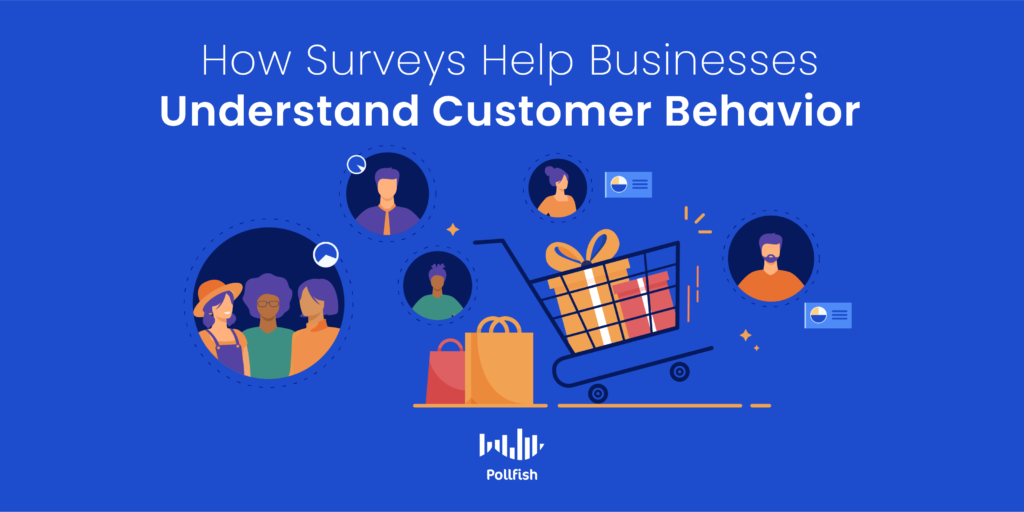Understanding Customer Behavior with Market Research

Customer behavior is one of the foremost areas of concentration in marketing, as consumers are the bedrock of a company’s success.
Businesses must therefore understand their customer behaviors in order to suit their needs and drive revenue. In fact, 66% of customers expect businesses to understand their needs and expectations.
But there is far much more to customer behavior than customer desires and expectations. This concept encompasses several facets of customer actions, along with the driving force behind them.
This article explores customer behavior, its importance, aspects and how a well-established campaign of market research techniques allows businesses to be well-acquainted with the customer behavior within their target market.
Defining Customer Behavior
Also called consumer behavior, customer behavior denotes the study of customers, particularly those in a target market, including the processes they use to choose, consume and discard products and services.
This field of study involves recording and examining customers’ mental, behavioral and emotional responses. Observing customer behavior goes beyond studying behaviors in a customer journey, that is, the actions customers take prior to making a purchase.
Rather, consumer behavior studies how customers choose products, why they avoid certain products, their buying behaviors, along with how they interact with a product or service. Thus, this concept transcends looking into what customers want and don’t want.
When studying these behaviors, researchers often incorporate scientific approaches, using notions from psychology and economics and even chemistry and biology.
Studying customer behavior can also involve studying organizations, especially for B2B businesses. However, B2C businesses can also stand to scrutinize companies as a kind of competitive analysis.
Consumer behavior is the study of individuals and organizations and how they select and use products and services. It is mainly concerned with psychology, motivations, and behavior.
The Key Aspects that Customer Behavior Investigates
As aforementioned, customer behavior takes various elements of customers into account, going beyond its subsets of customer journeys and customer buying behavior, which themselves span different concepts.
The following enumerates several key aspects that customer behavior encompasses.
- Buying habits, including locations, devices and frequencies
- Social trends and background factors that influence customers to make or avoid purchases
- Customer sentiment around product/service alternatives, such as related products/services, those from different brands
- Preferred methods of purchasing such as in-store versus online or both, at a large retailer or at a mom-and-pop shop, etc.
- Behaviors of customers as thy shop
- How customers search for companies
- How customers find businesses during their research
- Customer reasoning behind different alternatives
- How customers are influenced by their environments such as their friends, media, culture and other target market members
- How marketing campaigns influence or affect their behaviors
The Importance of Examining Customer Behavior
Studying this concept may appear to be laborious at worst and tedious at best, however, brands ought to avoid omitting it. This is because the aspects of customer behavior paint a critical picture of who customers are, allowing businesses to market and cater to them accordingly.
Understanding the customer behavior of customers allows companies to adapt and improve their marketing campaigns, sales promotions, customer service and more. Most importantly, it allows brands to influence their customers more productively.
Additionally, by understanding how customers choose, consume and discard products, businesses can identify issues in the products themselves and make innovations. In this way, studying customer behavior helps with product-related issues such as customer development and product satisfaction.
Businesses can therefore study it to find gaps and flaws in existing products and improve upon them. Or, they can create products with alternative features and even new products to gain a competitive advantage.

Studying consumer behavior also allows marketers to present their products more effectively, so that they can drive a maximum impact. That way, customers will be more keen on interacting with a business, whether they’ve long known about it or recently discovered it.
When customers engage with a business more frequently, they become far more exposed to marketing and advertising messages that can influence them to make purchases. In this way, engaging with a company, whether it is viewing their content or browsing their offerings lodges that company in customers’ minds, which is key for brand awareness.
Generally speaking, it is also ideal for customers to have businesses on their minds subconsciously. In fact, a Harvard Business School professor declares that 95% of purchases are made subconsciously in his book, How Customers Think: Essential Insights into the Mind of the Market. This book also discovered that the biggest drivers of unconscious urges are emotions.
All in all, examining consumer behavior enables businesses to become more attuned to their customers, thereby allowing them to better tailor their marketing efforts and retain customers for the long term.
Customer Behavior Patterns
It is important to identify the patterns that makeup customer behavior. Patterns are not to be confused with buying habits, as the latter refers to inclinations for an action that can become spontaneous, whereas patterns exhibit predictable occurrences.
Customer behavior patterns are also contrary to buying habits in that patterns are indicative of groups, while habits are more unique and individual-based.
The following explains the four customer behavior patterns:
- Items purchased: Businesses should study their customers’ shopping carts, as they reveal exactly what customers buy and how much of it they buy. Patterns usually show that customers buy everyday-use items in larger quantities and more frequently, while luxury items are bought less frequently and in smaller quantities.
- Customers tend to buy products based on the products’ perishability, a unit of sale, price, number of users of the product and the buying power of the customer.
- Place of Purchase: Customers usually shop at various stores, even when all of their intended products are available at just one. This largely depends on the accessibility of getting to various stores. When customers are not restricted to just one store due to transportation limitations, they are at liberty to choose items from multiple locations.
- Businesses must study place of purchase patterns, in that it will reveal customers’ choice of place, helping marketers understand which areas their customers visit.
- Purchase Method: The way a customer chooses to buy products divulges the kind of customer that they are. That is because there are various purchase methods, all of which tie into a customer journey.
- Customers can window shop online, then make up their minds at home and buy a product online. Or, they may buy a product in-store, via different payment options such as cash, debit or credit card.
- Businesses that gain this kind of insight into behavior patterns help them find ways to make customers buy again and more frequently.
- This pattern can also help businesses upsell products.
- Frequency and Timing of Purchase: Customers exhibit different times and frequencies of purchase. Regarding the former, they won’t all buy during business hours, given the prevalence of e-commerce, which allows them to shop at the earliest and latest parts of the day.
- Businesses can meet customer demands by studying their purchase timing and frequency in order to serve them better.
- Studying these concepts will help businesses adapt to regional (and global) time differences, along with seasonal variations.
The Things That Affect Customer Behavior
There are various influences and facets that can affect how customers behave. Businesses ought to acclimate themselves with these customer behavior factors, in that they all have a bearing on customer behavior and behavior patterns in one way or another.
When studying customer behavior based on these factors, businesses will be able to understand it more holistically. This helps in market segmentation and building customer personas, two market research tactics that allow businesses to gain a deeper understanding of their target market.

The following lists the critical factors of customer behavior:
- Purchasing power: even the wealthiest of customers are constrained to some sort of budget or need to buy things within their means. Thus, much of what customers buy depends on their purchasing power.
- Marketing campaigns: Specifically designed to persuade customers as well as reel in new ones, marketing campaigns have the capability to influence buying behaviors, when done correctly. They can prompt customers to switch brands or opt for a more expensive product with the correct messaging — which requires understanding your customers.
- Personality traits: Personality affects many kinds of behavior, including customer behavior. These spring from background and upbringing, which affect how people will behave in different settings. Some customers will be drawn to events (grand openings, sales, etc.) due to extroversion, while others may not be and some may fall in between.
- Personal preferences: The way customers choose purchases often relies on their personal preferences. Advertising and marketing campaigns can surely affect these but some preferences are unyielding. For example, a vegan will not buy animal-based products, while a meat lover is not going to shop for exclusively vegan items. Businesses should therefore be well-acquainted with the preferences of their target market.
- The economy: Economic conditions play a role in customer behavior, especially in relation to more expensive products; positive economic environments are bent on making customers more willing to indulge. In times of inflation, consumers are less likely to spend on expensive items, as well as make frequent purchases. Negative economic conditions are fruitful for businesses to introduce promotions and bargains.
- Group influence: Peer pressure and the opinions of others can also weigh heavily on buying and usage decisions. When customers’ friends and peers speak negatively or positively about an item or brand, it affects the way the customers perceive it. In some cases, group influence provides a setting of brand advocacy, while at other times, it can cause major reputational damage to a business.
- Social trends: Related to group influence, social trends set the scene in terms of what is popular and acceptable. From social media, to movies, blogs and podcasts, various talking points and fads can form and leave strong impressions among customers. Some of these platforms provide a breeding ground for new trends, the kinds that marketers can access, depending on their budget and strategy.
How Market Research Helps Businesses Understand Customer Behavior
Conducting market research enables businesses to understand all the key facets of customer behavior. There is much involved in market research, all of which can help marketers deliver more effective campaigns.
First off, market research encompasses a wide breadth of studies, from secondary research to primary research and from quantitative research to qualitative research. There is a vast pool of available resources, i.e., secondary sources available. These can take the form of industry news sites, statistics sources, published studies and more.
While secondary research is an important starting point for conducting market research, it does not address all the specific needs that a business may have, let alone the specific questions that businesses intend to probe their customers with.
As such, all businesses should turn to primary sources to understand their consumer behaviors. There are different routes for market researchers to take on this front; effective survey studies are the most useful. This is because surveys allow researchers to understand where their target market lies in all the factors and patterns of customer behavior.

For example, market researchers can conduct surveys to learn more about their customers’ purchasing power and how it relates to what they buy and how much. In addition, they can qualify only certain people from taking a survey, so that they can study respondents who fall within a particular income bracket.
Another example involves surveying customers based on their awareness levels of cultural trends and their opinions thereof.
In relation to studying customer buying patterns, surveys provide value, in that customers can ask detailed questions about all patterns, whether they are concerned with purchasing methods, the place of purchase, frequency, etc.
A strong online survey platform will allow businesses to gain a deep understanding of these aspects, through the use of advanced skip logic, which routes survey respondents to appropriate follow-up questions based on their answers to previous questions.
Finally, surveys allow market researchers to make decisions in an organized way, as they help form a customer behavior analysis report. This report reveals:
- How customers behave while researching, browsing products and purchasing
- How customers use products
- How long customers use their products
- What customers think and feel about different brands and product options
- How their environments affect their behavior
Improving Business Goals and Scaling by Understanding Your Target Market
Customer behavior to a business is like blood to mammals. While this may sound dramatic, it analogizes the importance of understanding your target market’s behavior. When businesses fail to study their customers’ behaviors, they are remiss on so many meaningful opportunities.
Thus, marketing campaigns of all sizes and calibers are at a much larger risk of failing. Market research, particularly survey research helps combat ignorance of customer behavior. This is because surveys give researchers the freedom to study any factor and pattern that relates to this behavior, arming them with critical insights on how customers shop throughout their journeys.
The most crucial component of survey research is using the correct online survey platform. Not all surveys offer advanced skip logic and can qualify respondents based on various demographics and psychographics. Thus, businesses and market researchers must invest in an online survey tool wisely, as it can make or break any market research campaign.
Pollfish Marketing Team
Ready to Try Pollfish?
Create your survey with AI, target high-quality respondents starting at $0.95 per complete, and start getting results in just minutes in real-time. From running a simple product concept survey to managing a constant stream of trackers for dozens of clients in dozens of countries, we’ve got you.
